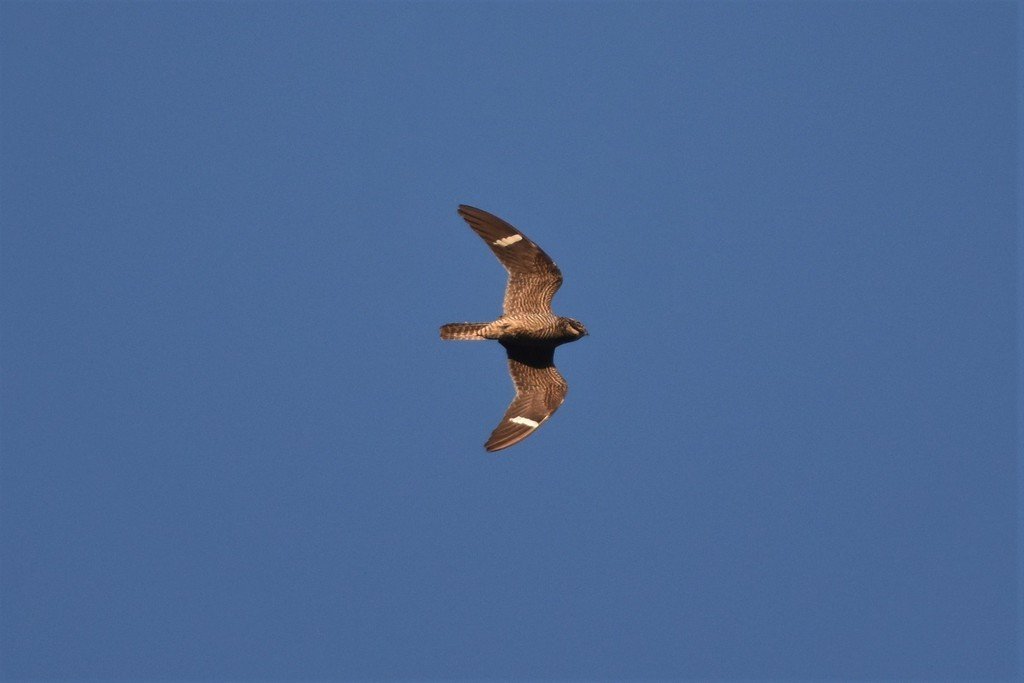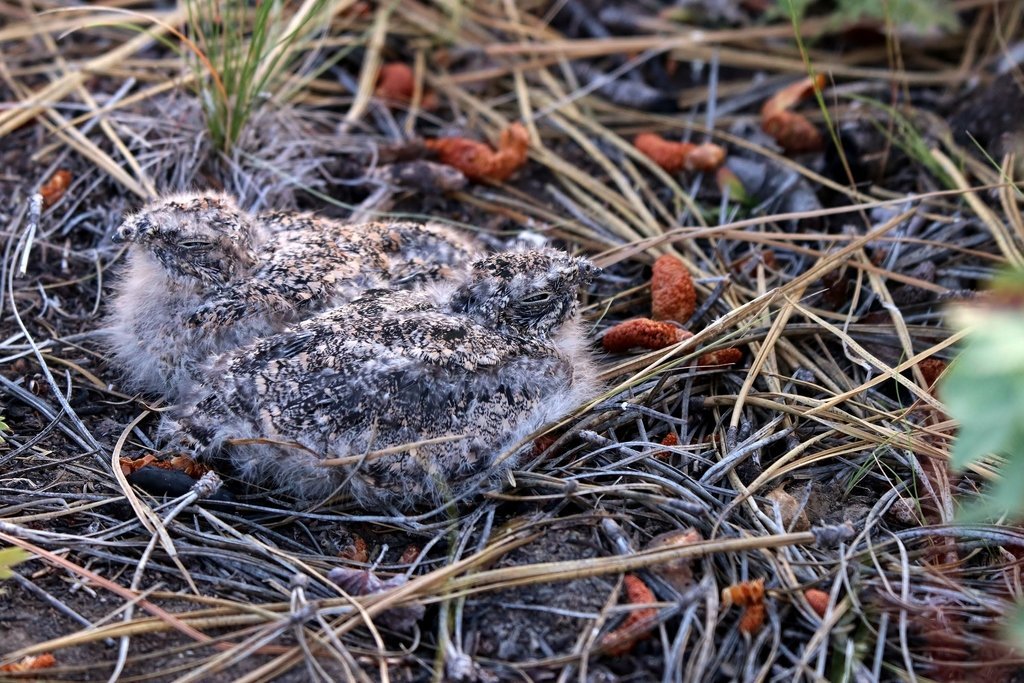The Not-So-Common, Not-A-Hawk
Each spring, as the ice begins to thaw, the forests, wetlands and prairies awaken to the sound of birdsong, brought by hundreds of migratory bird species arriving home to their summer breeding grounds.
Common Nighthawk (Chordeiles minor)
Whether they’re settling in for the summer, or just stopping by on their journey further north, these birds are undertaking an incredibly demanding feat to arrive in the environments around us. Urged by instinct, they follow the paths of the thousands of generations that flew these routes before them. The reward for their long journey North? An abundance of food, long daylight hours, and plenty of breeding space.
In Canada, the migratory bird breeding season generally extends from late March to August (Government of Canada, 2018). However, these birds cannot waste any time, for once they arrive in their summer breeding grounds, a race against the clock begins.
In those short few summer months, adults need to settle in a nesting spot, mate, incubate, and raise their young. They must forage for food, not only for themselves, but for their young chicks, who grow rapidly with an insatiable hunger. Within a few short weeks, the new chicks must become strong enough to tackle the migration south, flying thousands of kilometers to their winter feeding grounds. This all must take place before winter rolls around, when the forests, wetlands and prairies grow quiet once again.
Common Nighthawk (Chordeiles minor)
For AJM’s environmental scientists, the spring and summer months are also a busy time, filled with projects that keep our team in the field and on the move. A significant amount of our summer field work involves finding and protecting migratory bird nests, which are protected under the provincial Wildlife Acts (British Columbia Wildlife Act, 1994; Alberta Wildlife Act, RSA 2000) and the federal Migratory Birds Convention Act (1994).
During the 2022 field season, our environmental scientists encountered many nesting migratory bird species that had undertaken their migration North. One particularly memorable species was the Common Nighthawk (Chordeiles minor). Don’t let the ‘common’ in its name fool you though, the Common Nighthawk’s Southern Canada population has been estimated to have decreased by 68% since 1970 (COSEWIC, 2018). Due to its declining populations, the species has been listed as ‘threatened’ in the federal Species at Risk Act (SARA, 2002).
Common Nighthawk (Chordeiles minor)
Contrary to its name, the Common Nighthawk is also not a hawk, nor a raptor at all. It belongs to the nightjar family, a group of nocturnal birds that primarily feed on insects (COSEWIC, 2018). Even the ‘night’ in its name is a misnomer, as Common Nighthawks are crepuscular, meaning that they are most active at dawn and dusk (The Cornell Lab of Ornithology, n.d.).
This not-very-common, not-even-a-hawk has one of the longest migration routes of all North American migratory birds, travelling over 10,000 kilometers to Brazil and back each year (COSEWIC, 2018). It is known to breed in all Canadian provinces and territories, except for Nunavut.
Common Nighthawk (Chordeiles minor)
The Common Nighthawk prefers to nest in open, disturbed habitats (COSEWIC, 2018). It’s easy to see why our staff encountered this species during our summer migratory bird nest sweeps, particularly in construction areas. But this bird doesn’t even build a nest; it simply chooses a spot of bare earth and lays its eggs (usually a pair) directly on the ground, a testament to its confidence in its camouflage skills.
You may be thinking that this is a terrible strategy for giving its chicks the best start at life, but AJM’s staff can attest to the incredible effectiveness of the Common Nighthawk’s camouflage. Our environmental scientists have expended a lot of effort searching known nesting sites with no luck, just to have the adult bird flush from right beside their feet, only visible as it flew away.
It is not known why Common Nighthawk populations are decreasing so rapidly, but it is commonly thought that the issue lies with their insect food sources (Nebel et al., 2010). Insect populations are declining dramatically across North America due to habitat modification and the over-use of insecticides (Dirzo et al., 2014). Many insect-eating bird species have seen a similar population decline to that of the Common Nighthawk, indicating that a much bigger problem may be at large (Nebel et al., 2010).
A Common Nighthawk (Chordeiles minor) nest
Due to their threatened status, nesting Common Nighthawks require additional protective mitigation measures. Any Common Nighthawks found during a migratory bird nest sweep require a 200-metre protective buffer, opposed to the standard 30-metres applied for non-threatened species. No habitat clearing or construction activities are allowed within the protective buffer, ensuring that human influences do not result in chick mortality or adult abandonment.
This is particularly important for our not-so-Common Nighthawk, as its chicks are altricial (The Cornell Lab of Ornithology, n.d.). This means that they are very independent from a young age, much like a chicken. The chicks move around on their own in search for food, while the adult keeps a watchful eye. In doing so, they can wander far from their nest, oblivious to the circle of protection that has been placed around them. By implementing a large 200-metre buffer, we can be sure that these chicks are protected from construction activity, wherever they may roam.
For our team, each fledged chick is a success. Although we can’t control what befalls the Common Nighthawks after they take to the skies, we can ensure that our actions aren’t stopping their departure. As each migratory bird departs for the winter, we can only hope that when the ice begins to thaw, our forests, wetlands and prairies will awaken to their birdsong, once again.
Common Nighthawk (Chordeiles minor) chicks (Source: iNaturalist Canada. Photo 106520878, (c) Ian Adams, some rights reserved (CC BY), uploaded by Ian Adams)
By Madeleine Thom, AJM Environmental Scientist
References:
COSEWIC. 2018. COSEWIC assessment and status report on the Common Nighthawk (Chordeiles minor) in Canada. Committee on the Status of Endangered Wildlife in Canada. Ottawa. xi + 50 pp.
Dirzo, R., H. S. Young, M. Galetti, G. Ceballos, N.J.B. Isaac, and B. Collen. 2014. Defaunation in the Anthropocene. Science 345:401-406.
Government of Canada. 2018, October 30. Nesting Periods. Retrieved 31 January, 2023 from https://www.canada.ca/en/environment-climate-change/services/avoiding-harm-migratory-birds/general-nesting-periods/nesting-periods.html.
Migratory Birds Convention Act. SC 1994, c.22.
Nebel, S., A.M. Mills, J.D. McCracken, and P.D. Taylor. 2010. Declines of aerial insectivores in North America follow a geographic gradient. Avian Conservation and Ecology 5:1.
Species at Risk Act. SC 2002, c.29.
The Cornell Lab of Ornithology. n.d. Common Nighthawk Life History. Retrieved 31 January, 2023 from https://www.allaboutbirds.org/guide/Common_Nighthawk/lifehistory.
Wildlife Act. RSA 2000, c.W-10.
Wildlife Act. RSBC 1996, c.488.




